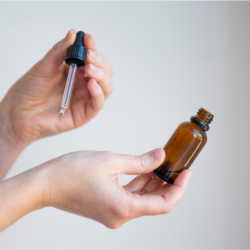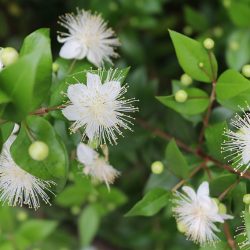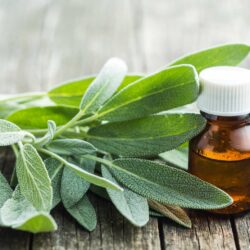Native to Central Asia or the Caucasus, garlic(Allium sativum) has been cultivated and eaten for over 6,000 years. It has always been considered a panacea. In ancient Rome, Pliny the Elder listed 61 illnesses that could be cured with garlic. Before the discovery of antibiotics, crushed garlic cloves were used, among other things, as an antiseptic to treat wounds.
A little history
What are the pharmacological properties of garlic bulb essential oil?
An intact garlic clove has little odour, but releases alliin when cut or crushed. This is due to the transformation of alliin by alliinase, an enzyme present in garlic. Alliicin is odorous and unstable, producing a number of compounds such as diallyl sulphide and ajoene.Alliin and another compound, S-allylcysteine, come from gamma-glutamylcysteine (0.9% of the weight of the clove). S-allylmercaptocysteine is also found in cold-preserved aged garlic.
Ajoene has a strong anti-thrombotic effect. It acts by penetrating the platelet membrane and reducing the viscosity of the lipid bilayer. It interferes with the fibrinogen receptor, inhibiting fibrinogen transport and the formation of thromboxane A2. Garlic cloves also contain phenolic acids and flavonoids, which are responsible for their antiseptic properties.
Anti-infectious properties
The bactericidal, fungicidal (anti-candidosis) and intestinal anti-parasitic (anthelmintic: roundworms, pinworms, taenia) properties of diallyl sulphide and other organosulphur compounds, the main constituents of garlic, have been demonstrated. In particular, the antimicrobial effect of diallyl sulphide has been demonstrated on Campylobacter jejuni, through inhibition of its bacterial biofilm.
Anti-infective and antibacterial, garlic essential oil is also effective against respiratory infections, as it passes through the lungs during partial elimination. In particular, this oil is reputed to inhibit the growth of methicillin-resistant Staphylococcus aureus(diallyl sulphide and diallyl disulphide).
Cardiovascular properties
Anti-hypertensive, with vasodilating activity in capillary arterioles according to Loeper; garlic essential oil also slows the pulse. This activity, which has been described several times, is due to its diuretic, angiotensin-converting enzyme inhibiting and blood vessel vasodilating properties.
As a platelet anti-aggregant, it increases fibrinolytic activity and prevents heart attacks.
Metabolic properties
Anticholesterolaemic by lowering plasma lipid levels, as demonstrated by numerous double-blind, placebo-controlled clinical studies, garlic essential oil has an anti-diabetic effect, significantly lowering blood sugar, serum cholesterol, triglycerides, erythrocyte glycated haemoglobin, and renal and hepatic peroxidation.
Anti-hepatotoxic, garlic essential oil stimulates the biosynthesis of phase II hepatic detoxification enzymes, especially DATS, and increases glutathione-S-transferase activity, thereby protecting the function and integrity of hepatic mitochondria. Garlic also activates the synthesis of constitutive androstane receptors, which are associated with the detoxification of liver cells exposed to xenobiotics such as oestrogens.
Garlic inhibits acetaminophen-induced toxicity. It reduces the risk of intoxication by heavy metals and solvents. Diallyl sulphide, one of the main constituents of garlic, is a CYP2E1 inhibitor, and plays a role in cellular prevention against alcohol, analgesics, xenobiotics and diseases such as HIV and diabetes.
Anti-cancer properties
Garlic essential oil is thought to prevent the formation of malignant tumours, particularly in the stomach and oesophagus (Chinese and Japanese studies). It is also of interest in cancer chemoprevention, stopping the division of liver tumour cells (G2/M phase of the cell cycle) and inducing apoptosis in lung cancer.
Other properties
Garlic is a digestive tonic that stimulates the appetite (often compared to cinchona). It is also antispasmodic and antiputrid. Molecular docking studies show that garlic’s organosulphur compounds (especially diallyl sulphide and triallyl sulphide) have anti-SARS-CoV-2 coronavirus activity.
Hormon-like (thyroid-stimulating and mild cortison-like), this essential oil is a glandular rebalancer. It is also effective against warts, corns and calluses, applied topically.
Some other plants used to reduce cholesterol levels
Traditional herbal medicine also uses the following plants to combat excess cholesterol:
The anticoagulant effects of garlic have been confirmed. These effects, added to those observed on cholesterol and blood pressure, could help prevent certain vascular diseases such as strokes.
Epidemiological studies have shown that people who eat large quantities of garlic have a lower risk of developing stomach, colon or prostate cancer. However, it is likely that this observation has more to do with their eating habits as a whole (heavy garlic eaters are often vegetarians).
What the health authorities think
The European Medicines Agency considers the use of garlic-based preparations to be “traditionally established” as a “complementary element in the prevention of atherosclerosis (cholesterol deposits on artery walls)” and “to relieve cold symptoms”.
The World Health Organisation considers the use of garlic to be “clinically established” as an “adjuvant [complementary] treatment to dietary measures aimed at lowering blood lipid levels (cholesterol and triglycerides)” and admits that garlic “may be useful in moderate hypertension”. The WHO considers the use of garlic in “the treatment of respiratory infections, intestinal worms, digestive disorders and osteoarthritis” to be “traditional”.
Commission E of the German Ministry of Health recognises the use of garlic in “the adjuvant treatment of diets designed to reduce blood lipids, and in the prevention of age-related vascular changes”.
The European Phytotherapy Cooperation recognises the use of garlic “in the prevention of atherosclerosis (the deposition of cholesterol on artery walls), in the treatment of excess blood lipids not controlled by diet, and in the treatment of respiratory infections (without clinical evidence)”.
The US National Institutes of Health consider the use of garlic to “moderately lower blood cholesterol levels (total and LDL) over a period of four to twelve weeks” to be “based on good scientific evidence”. They point out that there is little data on a longer-lasting effect or on the positive effect of garlic on HDL (‘good’) cholesterol.
How should garlic be used?
Recommended daily doses of fresh garlic vary. The WHO suggests four cloves a day, while Commission E recommends one clove.
In manufactured products, garlic can be found in dried or aged (fermented) form, and in extracts. Garlic is best eaten with meals to avoid stomach irritation. Applied topically to the skin, garlic in crushed, sliced, juiced or oily form can be irritating.
Garlic essential oil has many advantages. However, its allicin content limits its use. A professional should be consulted for personalised advice. Garlic is not recommended for use on the skin, as it can be dermocaustic. If it is used, it should be diluted: 1 or 2 drops in vegetable oil.
Garlic should only be taken orally on medical advice, as it can irritate mucous membranes. Garlic essential oil can be used in cooking, but its smell makes it difficult to use. It is preferable to use fresh or direct garlic.
For inhalation in the case of respiratory infections, dilute a few drops of garlic essential oil in simmering water. Cover the head with a towel and inhale for about ten minutes. Repeat three times a day. You can also place the oil on a handkerchief and inhale deeply.
Finally, garlic essential oil is not suitable for diffusion because of its strong, persistent odour.
Are there any precautions to be taken when using garlic essential oil?
- This oil contains sulphur
- Poor gastric tolerance at high doses
- Caution in cases of hypothyroidism
- Dermocaustic essential oil, dilute no more than 20% in a fatty substance
- Do not diffuse
- Not recommended for pregnant or breast-feeding women
- For adults only
- Do not use for prolonged periods
- Avoid contact with eyes
- Avoid in combination with cortisone, risk of drug interaction
- Do not use over a prolonged period, as there is a risk of resting the pituitary-adrenal axis and suffering acute adrenal insufficiency when the essential oil is stopped
- Avoid applying the essential oil in the evening (or before any period of rest)
- Not recommended for people suffering from osteoporosis, due to the inherent risk of decalcification
Pharmacokinetic interactions :
- No significant effect on the activity of CYP1A2, CYP2D6 and CYP3A4, but significant decrease in the activity of CYP2E1 acting on alcohol metabolism (Garlic is classified as a non-inhibitor of CYP3A4)
- CYP2C9 inhibitor
- Interactions with anti-HIV drugs(saquinavir, ritonavir)
Pharmacodynamic interactions :
- Theoretical risk of altering the effect of certain anti-diabetic drugs (additive effect)
- Interactions with aspirin, oral anticoagulants, warfarin and non-steroidal anti-inflammatory drugs (risk of haemorrhage)
- Do not take garlic supplements for at least 7 days before surgery
What are the characteristics of garlic?
Garlic (Allium sativum), used in cooking for its strong taste and smell, is a monocotyledonous perennial vegetable. Its head consists of several cloves. Native to Central Asia, it has been known in the Mediterranean region for 5,000 years and is appreciated for its taste and medicinal qualities.
Taxonomically, Allium sativum was described by Carl von Linné in 1753. There are several synonyms for this species, including Allium controversum and Allium ophioscorodon.
The plant measures 50 to 120 cm and has numerous leaves wrapped around its stem. Its inflorescence is rare and consists of white or pink flowers grouped in umbels, blooming in summer. The fruits are three-lobed capsules, but are rarely produced.
Ethnobotany suggests that it originated in Central Asia, with wild strains of little diversity. It has been used for 5,000 years, notably in Mesopotamia and Egypt. The Greeks and Romans attributed fortifying properties to it.
Garlic is known for its distinctive odour, which was even forbidden in temples dedicated to Cybele, according to Athenaeus. Garlic is a key ingredient in Provençal cuisine.Alexandre Dumas ‘s Grand Dictionnaire de cuisine mentions its use in various dishes. Hippocrates classified garlic as a sudorific medicine. The Crusaders contributed to its spread in Europe, where it was considered a panacea. Charlemagne recommended its cultivation on royal estates. Christopher Columbus is said to have introduced garlic to the Americas.
Cultivated worldwide, garlic prefers light, well-drained soil. It is planted in France from May and in Canada in October. French production in 2017 was 20,432 tonnes. Several garlic crops have been awarded the PGI label. Despite its appeal, garlic has not been the subject of much genetic research for breeding purposes. Its chromosome number is 2n=2x=16.
Medical literature and clinical trials:
- Thuy, B., My, T., Hai, N., Hieu, LT., Hoa, T. T., Thi Phuong Loan, H., Triet, NT., Anh, T., Quy, P. T., Tat, P. V., Hue, N. V., Quang, D. T., Trung, N. T., Tung, VT., Huynh, L. K., & Nhung, N. (2020). Investigation into SARS-CoV-2 Resistance of Compounds in Garlic Essential Oil. ACS omega
- Campbell, C. J. (2009). Analyses of essential and edible oils, and constituents therein, as candidate repellents for the yellow fever mosquito Aedes aegypti L.(Diptera: Culicidae) (Doctoral dissertation, Dept. of Biological Sciences-Simon Fraser University)
- Zadoyan G, Fuhr U. Phenotyping studies to assess the effects of phytopharmaceuticals on in vivo activity of main human cytochrome p450 enzymes. Planta Med. 2012
- Engdal S, Nilsen OG. In vitro inhibition of CYP3A4 by herbal remedies frequently used by cancer patients. Phytother Res. 2009
- Ho, B. E., Shen, D. D., McCune, J. S., Bui, T., Risler, L., Yang, Z., & Ho, R. J. (2010). Effects of Garlic on Cytochromes P450 2C9- and 3A4-Mediated Drug Metabolism in Human Hepatocytes. Scientia pharmaceutica
- Gallicano, K., Foster, B., & Choudhri, S. (2003). Effect of short-term administration of garlic supplements on single-dose ritonavir pharmacokinetics in healthy volunteers. British journal of clinical pharmacology
- Heck AM, DeWitt BA, Lukes AL. Potential interactions between alternative therapies and warfarin. Am J Health Syst Pharm. 2000
- AFSOS Association Francophone des Soins Oncologiques de Support
- Low C.F. et al, Inhibition oh hyphae formation and SIR2 expression in Candida albicans treated with fresh Allium sativum (garlic) extract, J Appl Microbiol, 2008
- Ried K. et al, Effect of garlic on blood pressure: a systematic review and meta-analysis, BMC Cardiovasc Disord, 2008
- Ezeala C. et al, Fresh Garlic Extract Protects The Liver Against Acetaminophen-Induced Toxicity, The Internet Journal of Nutrition and Wellness, 2008





